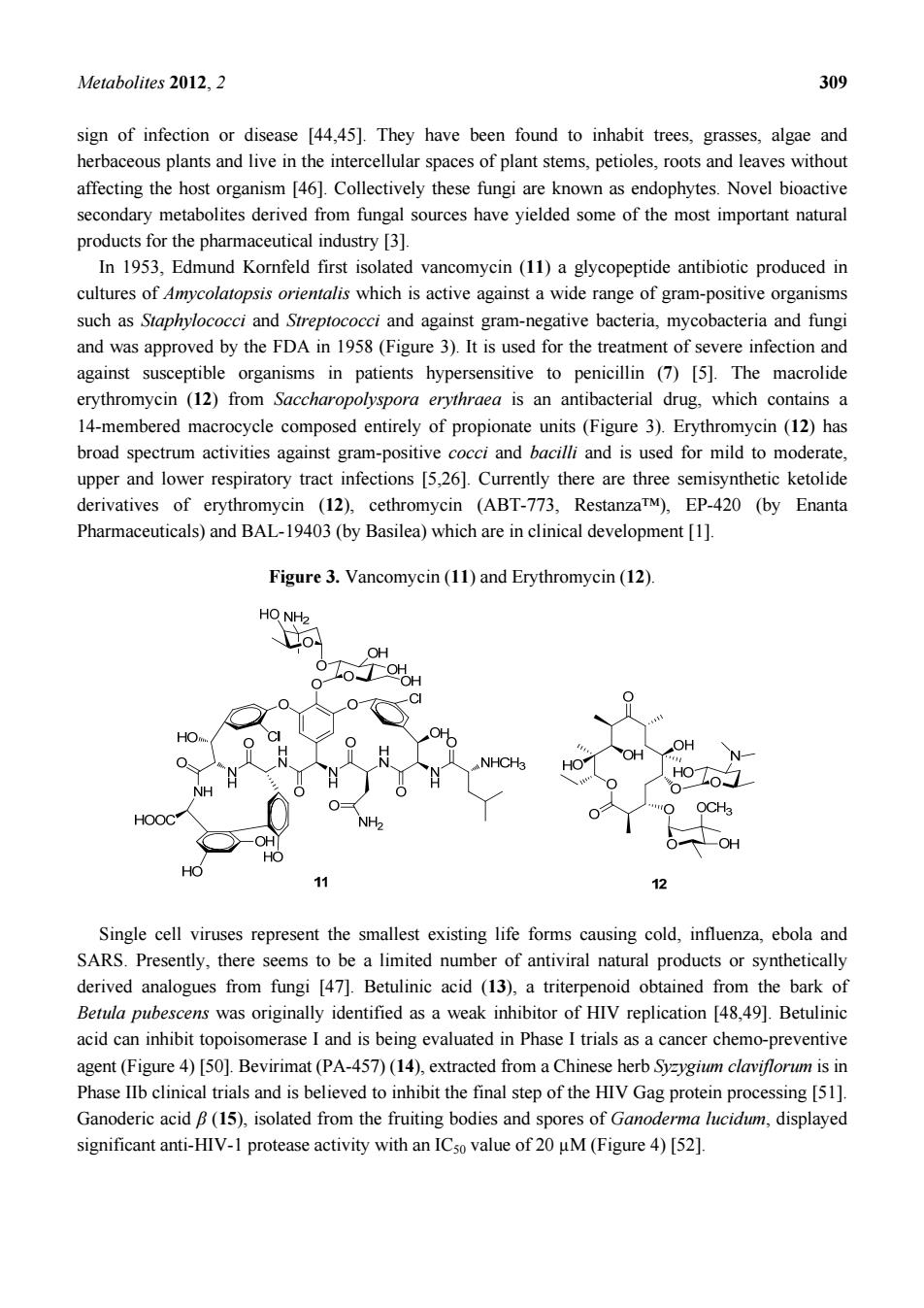正在加载图片...

Metabolites 2012.2 309 sign of infection or disease [44,45].They have been found to inhabit trees,grasses,algae and herbaceous plants and live in the intercellular spaces of plant stems,petioles,roots and leaves withou affecting the host organism [46].Collectively these fungi are known as endophytes.Novel bioactive secondary metabolites derived from fungal sources have yielded some of the most important natural products for the pharmaceutical industry [3]. In 1953.Edmund Kornfeld first isolated vancomycin(11)a glycopeptide antibiotic produced in cultures of Amycolatopsis orientalis which is active against a wide range of gram-positive organisms such as Staphvlococci and Streptococci and against gram-negative bacteria,mycobacteria and fungi and was approved by the FDA in 1958(Figure 3).It is used for the treatment of severe infection and against susceptible organisms in patients hypersensitive to penicillin (7)[5].The macrolide erythromycin (12)from Saccharopolyspora ervthraea is an antibacterial drug.which contains a 14-membered macrocycle composed entirely of propionate units(Figure 3).Erythromycin (12)has broad spectrum activities against gram-positive cocci and bacilli and is used for mild to moderate. upper and lower respiratory tract infections [5,26].Currently there are three semisynthetic ketolide derivatives of erythromycin (12).cethromycin (ABT-773.RestanzaTM).EP-420 (by Enanta Pharmaceuticals)and BAL-19403(by Basilea)which are in clinical development [1]. Figure 3.Vancomvcin (11)and Erythromvcin (12). 9 -C OH CH HOOC NH OH 11 Single cell viruses represent the smallest existing life forms causing cold,influenza,ebola and SARS.Presently,there seems to be a limited number of antiviral natural products or synthetically derived analogues from fungi [47].Betulinic acid (13),a triterpenoid obtained from the bark of Betula pubescens was originally identified as a weak inhibitor of HIV replication [48,49].Betulinic acid can inhibit topoisomerase I and is being evaluated in Phase I trials as a cancer chemo-preventive agent (Figure 4)[50].Bevirimat (PA-457)(14),extracted from a Chinese herb Syzygium claviflorum is in Phase IIb clinical trials and is believed to inhibit the final step of the HIV Gag protein processing [51] Ganoderic acid B(15),isolated from the fruiting bodies and spores of Ganoderma lucidum,displayed significant anti-HIV-1 protease activity with an ICso value of 20 uM (Figure 4)[52]. Metabolites 2012, 2 309 sign of infection or disease [44,45]. They have been found to inhabit trees, grasses, algae and herbaceous plants and live in the intercellular spaces of plant stems, petioles, roots and leaves without affecting the host organism [46]. Collectively these fungi are known as endophytes. Novel bioactive secondary metabolites derived from fungal sources have yielded some of the most important natural products for the pharmaceutical industry [3]. In 1953, Edmund Kornfeld first isolated vancomycin (11) a glycopeptide antibiotic produced in cultures of Amycolatopsis orientalis which is active against a wide range of gram-positive organisms such as Staphylococci and Streptococci and against gram-negative bacteria, mycobacteria and fungi and was approved by the FDA in 1958 (Figure 3). It is used for the treatment of severe infection and against susceptible organisms in patients hypersensitive to penicillin (7) [5]. The macrolide erythromycin (12) from Saccharopolyspora erythraea is an antibacterial drug, which contains a 14-membered macrocycle composed entirely of propionate units (Figure 3). Erythromycin (12) has broad spectrum activities against gram-positive cocci and bacilli and is used for mild to moderate, upper and lower respiratory tract infections [5,26]. Currently there are three semisynthetic ketolide derivatives of erythromycin (12), cethromycin (ABT-773, Restanza™), EP-420 (by Enanta Pharmaceuticals) and BAL-19403 (by Basilea) which are in clinical development [1]. Figure 3. Vancomycin (11) and Erythromycin (12). Single cell viruses represent the smallest existing life forms causing cold, influenza, ebola and SARS. Presently, there seems to be a limited number of antiviral natural products or synthetically derived analogues from fungi [47]. Betulinic acid (13), a triterpenoid obtained from the bark of Betula pubescens was originally identified as a weak inhibitor of HIV replication [48,49]. Betulinic acid can inhibit topoisomerase I and is being evaluated in Phase I trials as a cancer chemo-preventive agent (Figure 4) [50]. Bevirimat (PA-457) (14), extracted from a Chinese herb Syzygium claviflorum is in Phase IIb clinical trials and is believed to inhibit the final step of the HIV Gag protein processing [51]. Ganoderic acid β (15), isolated from the fruiting bodies and spores of Ganoderma lucidum, displayed significant anti-HIV-1 protease activity with an IC50 value of 20 µM (Figure 4) [52]